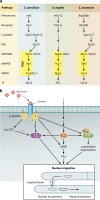Basidiomycete mating type genes and pheromone signaling
- PMID: 20190072
- PMCID: PMC2901643
- DOI: 10.1128/EC.00319-09
Basidiomycete mating type genes and pheromone signaling
Abstract
The genome sequences of the basidiomycete Agaricomycetes species Coprinopsis cinerea, Laccaria bicolor, Schizophyllum commune, Phanerochaete chrysosporium, and Postia placenta, as well as of Cryptococcus neoformans and Ustilago maydis, are now publicly available. Out of these fungi, C. cinerea, S. commune, and U. maydis, together with the budding yeast Saccharomyces cerevisiae, have been investigated for years genetically and molecularly for signaling in sexual reproduction. The comparison of the structure and organization of mating type genes in fungal genomes reveals an amazing conservation of genes regulating the sexual reproduction throughout the fungal kingdom. In agaricomycetes, two mating type loci, A, coding for homeodomain type transcription factors, and B, encoding a pheromone/receptor system, regulate the four typical mating interactions of tetrapolar species. Evidence for both A and B mating type genes can also be identified in basidiomycetes with bipolar systems, where only two mating interactions are seen. In some of these fungi, the B locus has lost its self/nonself discrimination ability and thus its specificity while retaining the other regulatory functions in development. In silico analyses now also permit the identification of putative components of the pheromone-dependent signaling pathways. Induction of these signaling cascades leads to development of dikaryotic mycelia, fruiting body formation, and meiotic spore production. In pheromone-dependent signaling, the role of heterotrimeric G proteins, components of a mitogen-activated protein kinase (MAPK) cascade, and cyclic AMP-dependent pathways can now be defined. Additionally, the pheromone-dependent signaling through monomeric, small GTPases potentially involved in creating the polarized cytoskeleton for reciprocal nuclear exchange and migration during mating is predicted.
Figures


References
-
- Asante-Owusu R. N., Banham A. H., Böhnert H. U., Mellor E. J., Casselton L. A. 1996. Heterodimerization between two classes of homeodomain proteins in the mushroom Coprinus cinereus brings together potential DNA-binding and activation domains. Gene 175:25–31 - PubMed
-
- Badalyan S. M., Polak E., Hermann R., Aebi M., Kües U. 2004. Role of peg formation in clamp cell fusion of homobasidiomycete fungi. J. Basic Microbiol. 44:167–177 - PubMed
-
- Bakkeren G., Kämper J., Schirawski J. 2008. Sex in smut fungi: structure, function and evolution of mating-type complexes. Fungal Genet. Biol. 45S:15–21 - PubMed
Publication types
MeSH terms
Substances
LinkOut - more resources
Full Text Sources

